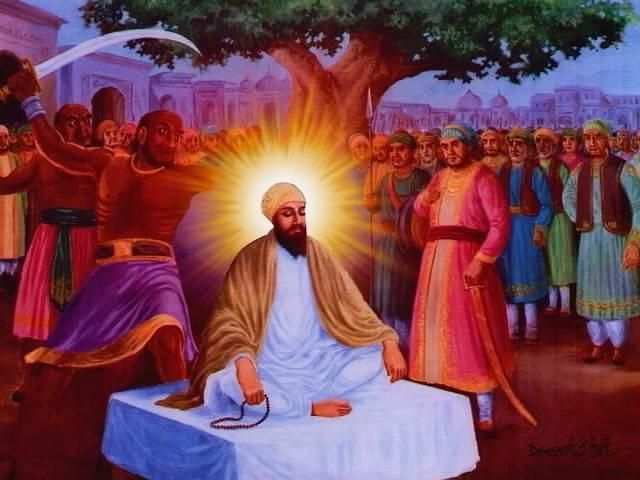New Delhi: Nestled between a church and a masjid stands Gurdwara Rakab Ganj Sahib in New Delhi. To an ordinary traveller in the city, this may not be the most well-known gurdwara, but the place holds deep significance to the Sikh community. Rakab Ganj Sahib is the resting place of the ninth guru of Sikhism — Guru Tegh Bahadur. Almost 300 odd years ago, this was the exact place that the dismembered body of Guru Tegh Bahadur was cremated.
There are multiple versions of how Guru Tegh Bahadur eventually met his end, but almost all agree that his sacrifice was one of a kind, since he died for the Hindus. “It is perhaps not imprudent to call him the greatest humanitarian this world has ever seen,” says a member of the Delhi Sikh Gurdwara Management Committee (DSGMC), which is headquartered at Rakab Ganj Sahib. “No one else sacrificed himself for the people of another religion.”
Guru Tegh Bahadur died on 24 November 1675.
Guru Tegh Bahadur’s martyrdom
In the late 17th century, Mughal emperor Aurangzeb imposed the Sharia law across his empire and an additional jizya tax on non-Muslims. It is also believed that he forcibly converted many people to Islam.
According to Sikh tradition, some Kashmiri Pandits fled these forced conversions and sought refuge with Guru Tegh Bahadur. On the insistence of his son who would eventually be known as Guru Gobind Singh, the ninth guru travelled to Delhi to dissuade Aurangzeb from this religious imposition.
Here, the story has different versions — some say Aurangzeb asked him to perform a miracle, which he chose not to do and the emperor beheaded him, while others believe Aurangzeb asked the Hindus to bring forth someone willing to sacrifice himself for their religion and Guru Tegh volunteered himself.
Aurangzeb beheaded Guru Tegh Bahadur on 24 November 1675, in front of a massive crowd. Gurdwara Sis Ganj Sahib in Chandni Chowk marks the place of his execution.
Historian Haroon Khalid wrote that Aurangzeb forbade anyone from moving the decapitated head of Guru Tegh Bahadur, but two of his followers defied his orders.
According to information available at the gurdwara, Bhai Jaita Ji took the Guru’s head to Anandpur, the city the guru had founded, while Bhai Lakhi Shah Vanjara Ji took the body to his village, Rakab Ganj, and cremated the body by setting his own house on fire, to avoid arousing the suspicion of Mughal soldiers.
This is how Gurdwara Rakab Ganj Sahib got its name.
Also read: Zafarnama, the ‘victory letter’ that Guru Gobind Singh wrote to Aurangzeb
His legacy continues
While official history might not be in consensus with the entire legend associated with Guru Tegh Bahadur, the key takeaway from his life and death is the exercise of choice and freedom in matters of faith. One of the prominent teachings of the Guru was that one should be willing to follow a faith, rather than be coerced into it.
“For him and even for Guru Nanakji, the religious question was about the extent of one’s faith, beyond the externalities associated with the religion. They emphasised love, charity, brotherhood and peace over and beyond mere tokens. This is one of the reason, the gurus refused to wear the janeu (sacred thread of Hindus),” says the DSGMC member.
In today’s time, he adds, such a lesson becomes even more important. “We see people yelling themselves hoarse over extremely inconsequential matters and more importantly, in today’s time, religious freedom has become even more constricted and this is perhaps the best time to remember Guru Tegh Bahadur.”
Also read: Guru Ram Das, who founded Amritsar and composed the hymns sung at Sikh weddings




This history is forged by fanatic hindus and sikhs……it is the biggest blunder and lie that king aurangzeb forcfully converted hindus and raped hindu womens,kashmri hindus kied to guruji and guruji started rebellion against the mughal regime ,because of this aurangzeb send wazir khan to crush rebellion ,but he did some atricities against sikhs and killed two children of guruji’s which is a really condemnable which is against humanity and islamic teachings,but why guruji fled away why guruji didnt come to surrender and save his childrens…..real history never told ,and thus got chance to fanatic hindus and sikhs to tarnish image of king aurangzeb not only auranzeb but all of muslims…
You guys are despicable, had to bring the Janeu angle…..
Sikhism was widely considered a part of Hinduism until the Khalistan movement.
In all Mughal, British, Indian censuses until 1970s, Sikhs and Hindus are counted together.
Let us also remember the atrocities committed by Aurangzeb against Hindus .
Historians or to be precise fiction writers like Irfan Habib and Romila Thapar are trying their best to whitewash brutalites carried out by a Islamic bigot like Aurangjeb